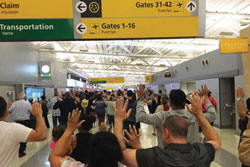A shooting was reported at John F. Kennedy (JFK) Airport in New York in August. Traveling Monmouth University students were present as terminals were evacuated and passengers were fleeing for their lives, however, it was later revealed that the entire situation was a false alarm.
The ‘shooting’ began in Terminal eight of the eight-terminal airport. Just before 9:35 p.m., Usain Bolt finished his 100-meter Olympic dash, scoring a gold medal for his home country of Jamaica; those watching cheered and clapped. It was the sound of cheering and clapping that caused others in the terminal to think they were under attack.
The situation quickly spiraled into chaos. Passengers stampeded through the terminal, and there seemed to be a lack of responding security according to New York Magazine. Passengers were not reasonably evacuated, at least in the beginning; they instead they fled onto the tarmac, into the hallways, and throughout the airport. The sounds of metal poles falling to the ground as the crowd pushed through them sounded like more gunshots, only increasing the panic.
About forty-five minutes later, there was yet another false alarm in Terminal One, JFK’s international terminal.
In Terminal One was a handful of Monmouth University students about to depart for a three-week backpacking trip through Copenhagen. Their flight had been delayed. They were at the end of the terminal, according to junior political science student Christopher Summers, and there were no exits except for the secured gates that connected the planes to the terminal.
“We were actually waiting for our flight and had almost finished our beers when what sounded like a wild stampede broke out,” said Summers, recounting the experience. “People were screaming, ‘Run for your lives. Shooter! Shooter!’ At that moment, the sound of shattering glass and screams caused the everyone to drop everything and move toward the end of the terminal.”
Summer said that he was separated from his fellow students, as they all scattered in an attempt to protect themselves.
“Most of the people dove on the ground and tried hiding underneath terminal benches and chairs… Personally, it was the scariest moment of my life and I witnessed people trampling each other,” he said.
Summers found a place to hide when he saw an airport employee scanning his card to open a security door to a gate. The employee initially refused to open the door, despite the people banging on it; Summers said he was able to convince the employee that opening the door was the right thing to do.
“We kept funneling people into the small corridor,” he said. “Some people were crying, some were in utter shock, and I somehow kept my cool with a few others as the pounding on the doors heightened the tension in the room. I cannot remember what it was, but something caused all the people in the tunnel to immediately rush further down to were a plane may have been docked. I ran ahead of the to try to find a way out because we would have been sitting ducks. I opened the two steel doors to find there was no airplane, but rather a 50 foot drop to the tarmac. It would have been the last resort, but I kid you not– some people were seriously considering to jump.”
After 20 minutes of chaos, Summers said that the police arrived and ordered people to remain on the ground as the terminal was cleared. When he was given permission to enter the terminal again, it was still chaotic – sirens were blaring, police officers held assault rifles, and the room was covered in abandoned suitcases and shattered glass.
Even though there was no apparent threat, there was still confusion and a lack of consensus on what had happened.
“It was not until I found some of our bags and began to walk back to where the security check in was that I heard a TSA talking with a US Marshall that I heard that it was a misfiring of a police officer’s gun that startled everyone in the terminal,” said Summers. “I walked back out into the area before security where everyone was starting to exit into the drop off area (outside), when another stampede occurred and I was forced to avoid the chaos, but heard a police officer with an assault rifle yell “run for your life”. I was so confused/shocked/completely over the commotion that I walked up an escalator to where another US Marshall was located guarding a skywalk/bridge who directed me to stay in there until he figured out what was going on. Honestly, at that point, not one thing was conveyed to anyone about whether there was a shooter or not, and the response time/ handling of the situation by the authorities was less than acceptable. It was not until about two hours later, on social media, that I found out that there was no shooter.”
Following the false alarm, there was widespread criticism of the security response to the attack. New York Governor Andrew Cuomo said, in a statement, that he would create a review panel to investigate the events that caused the chaos, and how to better create a more effective security response.
“The whole incident was unfortunate, but actually we can learn from these situations,” said Cuomo. “I’m putting together a multiagency team of state officials who will then review the response to see how we can make it better.”
Summers also expressed criticism and frustration at the security and police response.
“Where were the police/response teams?” he asked. “Why were airport authorities and employees yelling run for your lives and not conducting people on what to do? Why was there a second surge of people as I exited the terminal? Basically, if there had been a shooter, there would have been a lot of casualties & it is a disappointment that the media glanced over the story becauseit would have brought much needed attention to the inefficiencies that occurred that night (in NYC’s largest airport).”
Bill McElrath, chief of the Monmouth University Police Department (MUPD) said that the MUPD was aware of the false alarm, but he didn’t know that Monmouth students had been present at the time.
“The University has a Managing Emergencies Abroad Policy,” McElrath said. He then commented on plans that existed for attacks taking place on campus. “It would naturally depend on the nature of the attack. The University Police have an Emergency Operations Plan which we would follow in the event of an emergency.”
There are plans for situations such as active shooters, hostage and terrorism situations, campus evacuations, and campus-wide lockdowns.
“Some of these policies are made available to the campus community,” he said. “Others are confidential and MUPD specific as they are internal policies on how the Police will respond to a specific type of incident. The University takes campus safety very seriously, whether a student is on campus, off campus, studying abroad or travelling. We regularly review all policies and modify and update them as needed.”
No casualties were reported after the false alarm, though there were reports of hospitalizations due to injuries sustained in the stampedes. Ultimately, it was determined that no shots were fired.
“To me and the guys I was traveling with, as well as the rest of the people in that terminal that night, the experience was an attack without the bullets,” said Summers.



